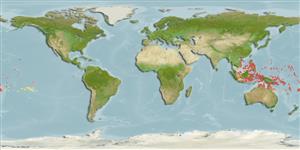>
Atheriniformes (Silversides) >
Atherinidae (Silversides) > Atherinomorinae
Etymology: Stenatherina: Greek, stenos =narrow + Greek, atherina, the Greek name for the eperlane; 1770 (Ref. 45335).
More on authors: Jordan & Richardson.
Environment: milieu / climate zone / depth range / distribution range
Ecologia
marinhas associadas(os) a recifes; intervalo de profundidade 1 - 20 m (Ref. 86942). Tropical; 19°N - 20°S
Pacific Ocean: Sumatra and the northern Cook Islands, north to the Philippines, Caroline Islands, and Marshall Islands, south to Fiji.
Tamanho / Peso / Idade
Maturity: Lm ? range ? - ? cm
Max length : 11.0 cm TL macho/indeterminado; (Ref. 9760)
Descrição suscinta
Chaves de identificação | Morfologia | Morfometria
Espinhos dorsais (total) : 5 - 8; Raios dorsais (total) : 8 - 10; Espinhos anais: 1; Raios anais : 9 - 12. Vomerine teeth forming a characteristic T pattern. Ascending process of premaxilla long, extending past orbit into interorbital space; lateral process very long and pungent. Gill rakers long and slender, longer than half the diameter of pupil. Interdorsal scales 8-10. Distinct crescentic mark present on snout immediately in front of eye; upper part of midlateral band terminating as half crescent on upper lobe of caudal fin.
Preferred habitat appears to be deeper enclosed atoll lagoons, reefs, coastal waters and harbors. May gather in schools at night when attracted to light but generally not found in very large numbers. May be taken as food by larger commercial species (Ref. 9760).
Ciclo de vida ou comportamento de acasalamento
Maturidade | Reprodução | Desova | Ovos | Fecundidade | Larvas
Oviparous, distinct pairing during breeding (Ref. 205).
Myers, R.F., 1991. Micronesian reef fishes. Second Ed. Coral Graphics, Barrigada, Guam. 298 p. (Ref. 1602)
Status na Lista Vermelha da UICN (Ref. 130435: Version 2024-2)
Ameaça para os humanos
Harmless
Uso pelos humanos
Pescarias: pouco comercial; isca: occasionally
Ferramentas
Relatórios especiais
Baixar XML
Fontes da internet
Estimates based on models
Preferred temperature (Ref.
123201): 26.7 - 29.3, mean 28.7 °C (based on 1304 cells).
Índice de diversidade filogenética (Ref.
82804): PD
50 = 1.0000 [Uniqueness, from 0.5 = low to 2.0 = high].
Bayesian length-weight: a=0.00562 (0.00240 - 0.01320), b=3.15 (2.95 - 3.35), in cm total length, based on LWR estimates for this (Sub)family-body shape (Ref.
93245).
Nível Trófico (Ref.
69278): 3.3 ±0.4 se; based on size and trophs of closest relatives
Resiliência (Ref.
120179): Elevada, tempo mínimo de duplicação da população menor que 15 meses (Preliminary K or Fecundity.).
Fishing Vulnerability (Ref.
59153): Low vulnerability (10 of 100).
Nutrients (Ref.
124155): Calcium = 109 [59, 211] mg/100g; Iron = 0.693 [0.404, 1.257] mg/100g; Protein = 19.4 [17.1, 21.8] %; Omega3 = 0.14 [0.06, 0.36] g/100g; Selenium = 21.7 [10.3, 49.4] μg/100g; VitaminA = 181 [57, 527] μg/100g; Zinc = 1.82 [1.23, 2.59] mg/100g (wet weight);
